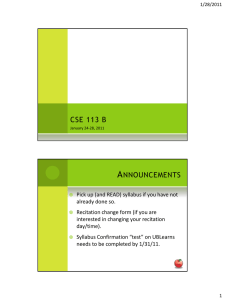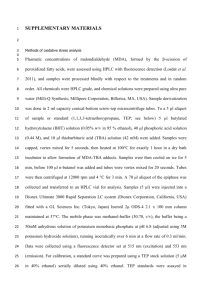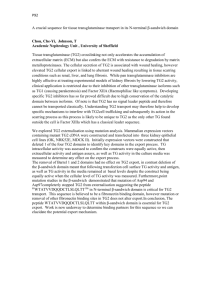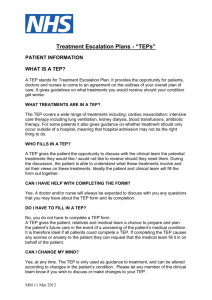A. Title: B. Author C. Abstract: Lentisphaera araneosa
advertisement
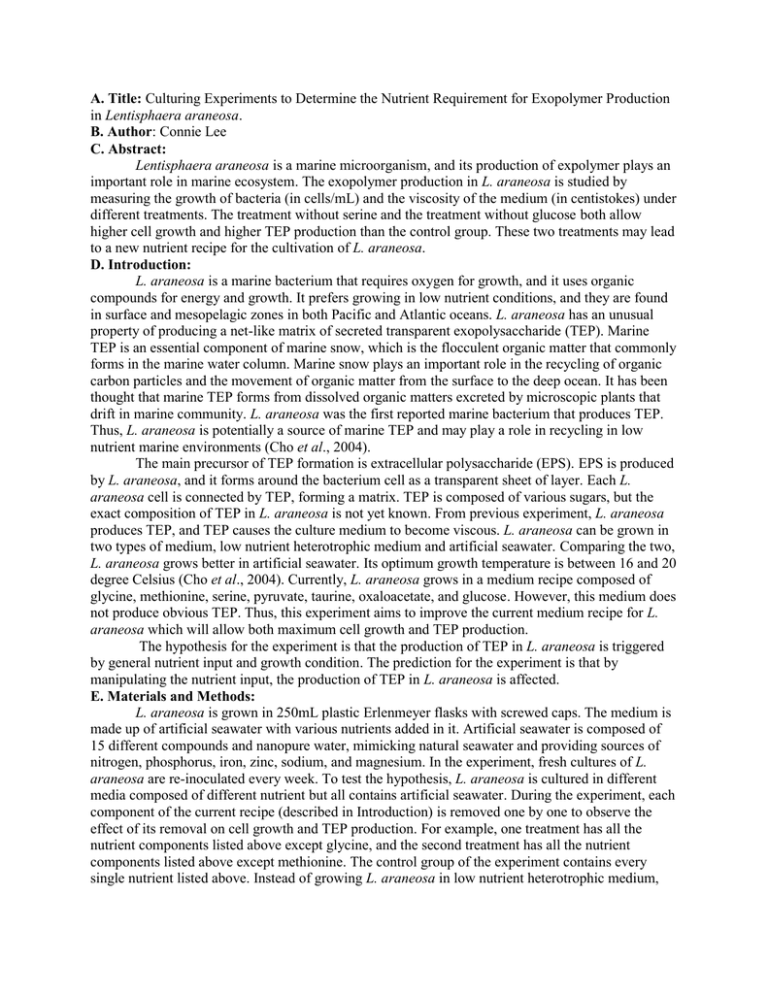
A. Title: Culturing Experiments to Determine the Nutrient Requirement for Exopolymer Production in Lentisphaera araneosa. B. Author: Connie Lee C. Abstract: Lentisphaera araneosa is a marine microorganism, and its production of expolymer plays an important role in marine ecosystem. The exopolymer production in L. araneosa is studied by measuring the growth of bacteria (in cells/mL) and the viscosity of the medium (in centistokes) under different treatments. The treatment without serine and the treatment without glucose both allow higher cell growth and higher TEP production than the control group. These two treatments may lead to a new nutrient recipe for the cultivation of L. araneosa. D. Introduction: L. araneosa is a marine bacterium that requires oxygen for growth, and it uses organic compounds for energy and growth. It prefers growing in low nutrient conditions, and they are found in surface and mesopelagic zones in both Pacific and Atlantic oceans. L. araneosa has an unusual property of producing a net-like matrix of secreted transparent exopolysaccharide (TEP). Marine TEP is an essential component of marine snow, which is the flocculent organic matter that commonly forms in the marine water column. Marine snow plays an important role in the recycling of organic carbon particles and the movement of organic matter from the surface to the deep ocean. It has been thought that marine TEP forms from dissolved organic matters excreted by microscopic plants that drift in marine community. L. araneosa was the first reported marine bacterium that produces TEP. Thus, L. araneosa is potentially a source of marine TEP and may play a role in recycling in low nutrient marine environments (Cho et al., 2004). The main precursor of TEP formation is extracellular polysaccharide (EPS). EPS is produced by L. araneosa, and it forms around the bacterium cell as a transparent sheet of layer. Each L. araneosa cell is connected by TEP, forming a matrix. TEP is composed of various sugars, but the exact composition of TEP in L. araneosa is not yet known. From previous experiment, L. araneosa produces TEP, and TEP causes the culture medium to become viscous. L. araneosa can be grown in two types of medium, low nutrient heterotrophic medium and artificial seawater. Comparing the two, L. araneosa grows better in artificial seawater. Its optimum growth temperature is between 16 and 20 degree Celsius (Cho et al., 2004). Currently, L. araneosa grows in a medium recipe composed of glycine, methionine, serine, pyruvate, taurine, oxaloacetate, and glucose. However, this medium does not produce obvious TEP. Thus, this experiment aims to improve the current medium recipe for L. araneosa which will allow both maximum cell growth and TEP production. The hypothesis for the experiment is that the production of TEP in L. araneosa is triggered by general nutrient input and growth condition. The prediction for the experiment is that by manipulating the nutrient input, the production of TEP in L. araneosa is affected. E. Materials and Methods: L. araneosa is grown in 250mL plastic Erlenmeyer flasks with screwed caps. The medium is made up of artificial seawater with various nutrients added in it. Artificial seawater is composed of 15 different compounds and nanopure water, mimicking natural seawater and providing sources of nitrogen, phosphorus, iron, zinc, sodium, and magnesium. In the experiment, fresh cultures of L. araneosa are re-inoculated every week. To test the hypothesis, L. araneosa is cultured in different media composed of different nutrient but all contains artificial seawater. During the experiment, each component of the current recipe (described in Introduction) is removed one by one to observe the effect of its removal on cell growth and TEP production. For example, one treatment has all the nutrient components listed above except glycine, and the second treatment has all the nutrient components listed above except methionine. The control group of the experiment contains every single nutrient listed above. Instead of growing L. araneosa in low nutrient heterotrophic medium, they are grown in artificial seawater since L. araneosa has a better growth in artificial seawater. The cultures are incubated under 16 degree Celsius. During the experiment, the cell growth of L. araneosa is monitored and recorded with Guava EasyCyte flow cytometer. Since the production of TEP causes the culture medium to be viscous, TEP production is measured by testing the viscosity of the media with a glass viscometer (the specific viscosity constant for the viscometer is 0.003 centistokes). Using the viscometer, the time it takes for the culture to flow over a certain distance is measured. By multiplying the measured time with the specific viscosity constant, the kinematic viscosity of the culture in centistokes can be obtained. Using this data, the relative viscosities of the cultures can be compared to examine the effects of different treatments on the TEP production of L. araneosa. F. Results: Comparing the results, L. araneosa grows better under treatments that have no glycine, serine, taurine, or glucose than the control group with every single nutrient in the medium. On the other hand, without methionine or without oxaloacetate, L. araneosa cannot grow well comparing to the others. Generally, the viscosities of all treatments increased over time, meaning that TEP is produced. L. araneosa grows to the highest viscosity among all in the treatment without glucose. Also, L. araneosa grows to the second highest viscosity in the treatment without serine. The control group gives the third highest viscosity. G. Discussion: By breaking down the mixed carbon components individually, one can determine the specific combination of nutrient(s) required for TEP production and cell growth in L. araneosa. Comparing figure A and B, one can observe that TEP production in L. araneosa happens during the late exponential and stationary phase. Different treatments give different levels of cell growths and TEP productions of L. araneosa. The cultures without methionine or without oxaloacetate cannot grow well. This observation may be because methionine and oxaloacetate are essential components for the metabolisms of L. araneosa. On the other hand, cultures without serine or without glucose gave both higher cell densities and higher TEP production than the control group. Serine and glucose are usually the major carbon sources for organisms, but majority of the marine microorganisms do not require these two components for growth. Likewise, L. araneosa may have other mechanisms that utilize other carbon sources for growth, allowing it to grow well without serine or without glucose. Also, eliminating serine or glucose may reduce competition between substrates for specific enzymes, which may be one of the reasons that L. araneosa has higher cell growth when there is no serine or no glucose. Since L. araneosa can grow better without serine or without glucose, this result may possibly lead to a new nutrient recipe for the growth and TEP production of L. araneosa. However, the experiment only provides screening result for the development of new cultivation recipe. Further investigation on different combinations is need for a more complete insight on L. araneosa’s nutrient requirements for cell growth and TEP production. H.References: Cho J.C., Vergin K.L., Morris R.M., and Giovannoni S.J., 2004, Lentisphaera araneosa gen. nov., sp. nov, a transparent exopolymer producing marine bacterium, and the description of a novel bacterial phylum, Lentisphaerae, Environmental Microbiology, v. 6, p. 611–621
